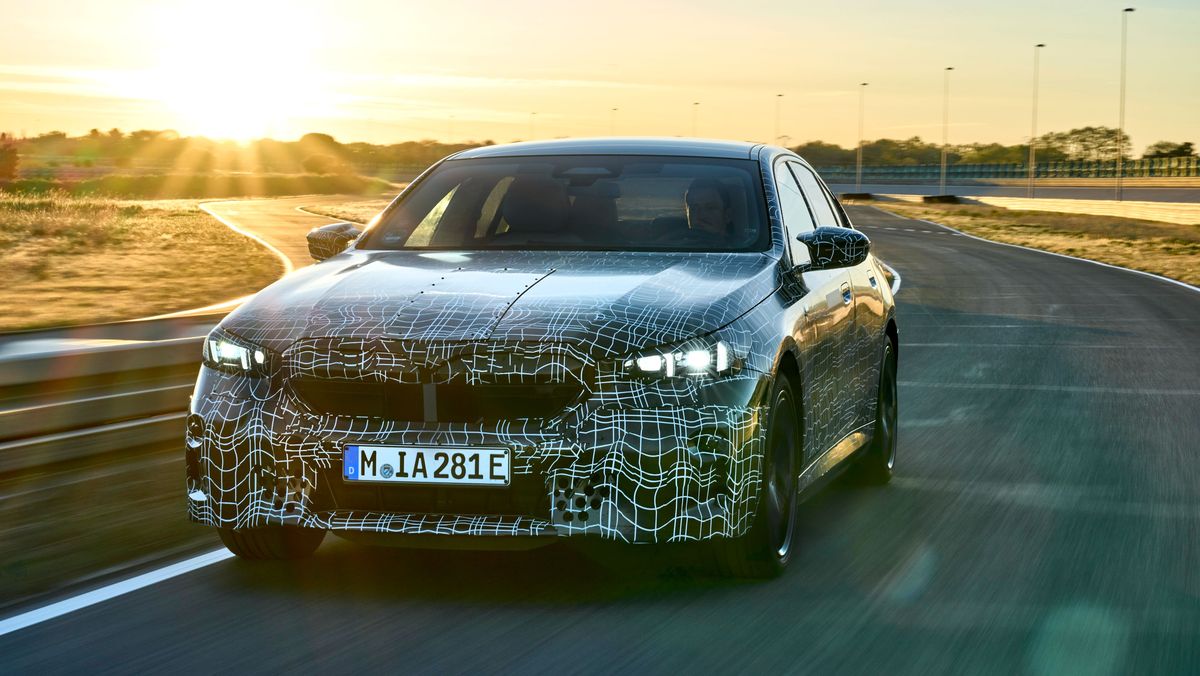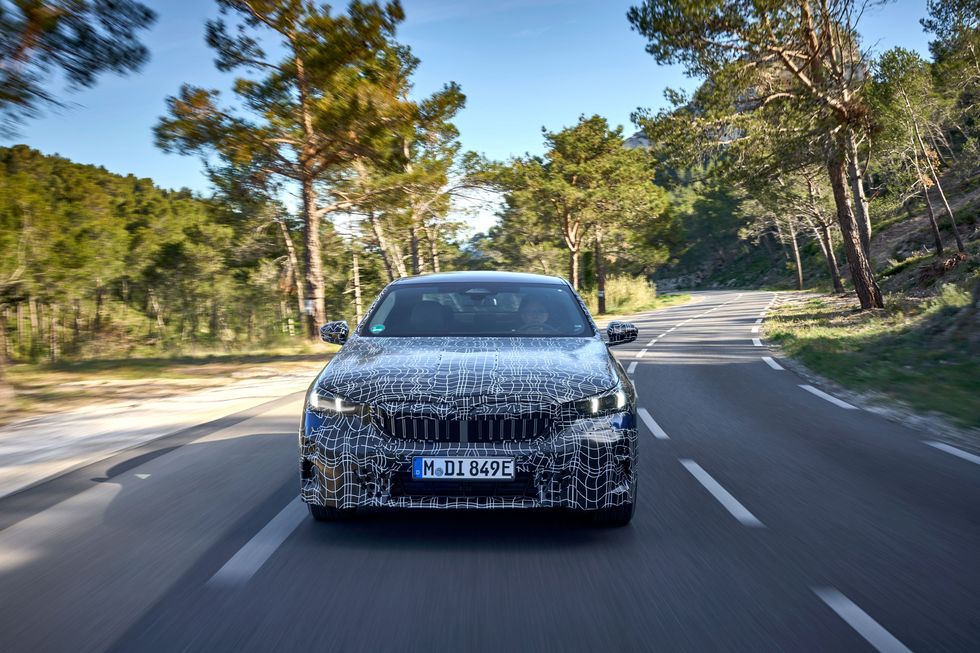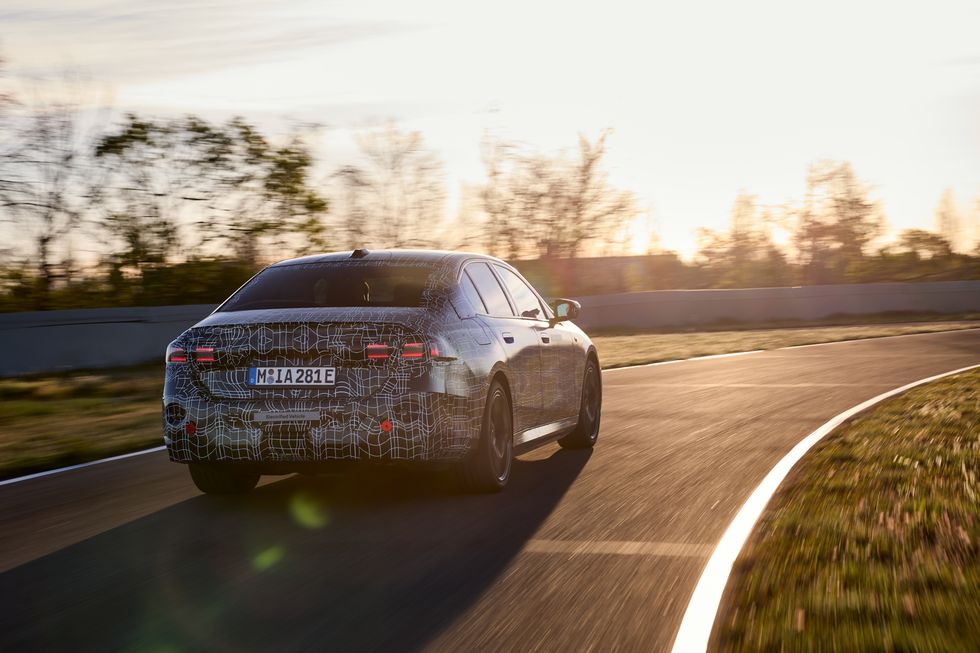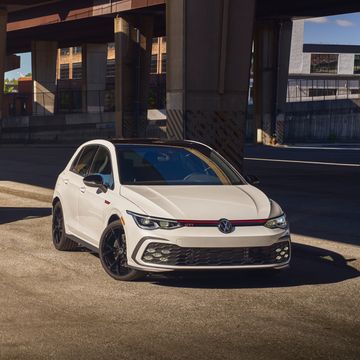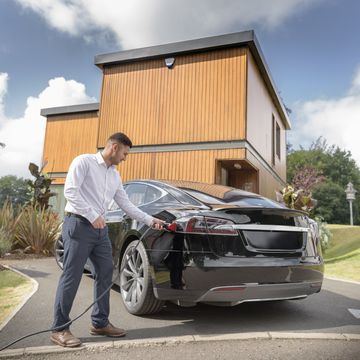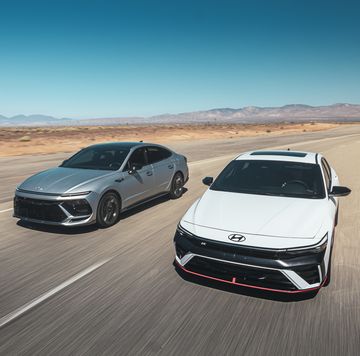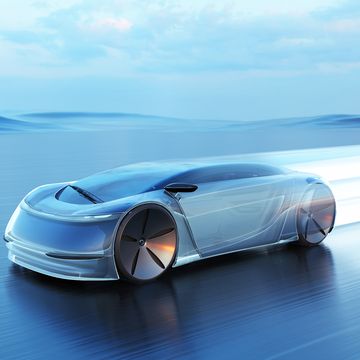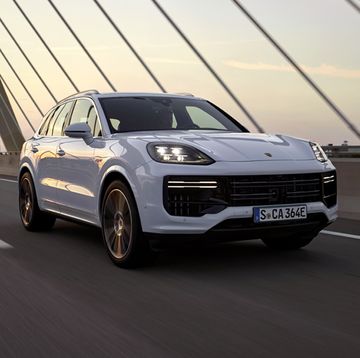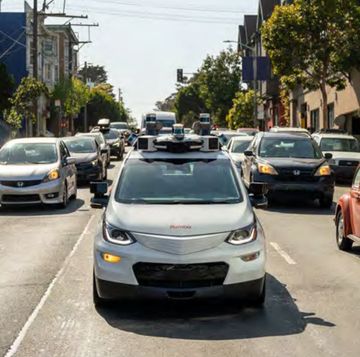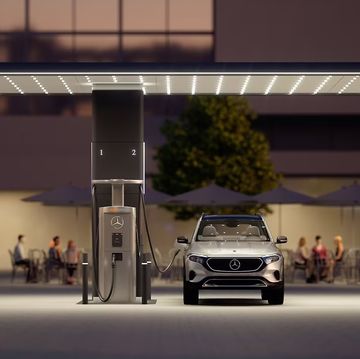- The BMW i5 is the all-electric sub-model of the 5-Series, and when the eighth-generation of the vaunted nameplate launches in October, the EV version will come in two varieties, as the rear-drive i5 eDrive 40 sporting a single 340-hp electric motor, and the i5 M60 xDrive with its twin electric motors, 598 hp, and all-wheel drive.
- Both i5 versions are expected to deliver 295 miles of range in the EPA cycle.
- Also look for revised infotainment options and more autonomous tech, including a feature that allows you change lanes just by glancing in the mirror.
The 5-series is as integral to BMW as model designations based on vehicle and engine sizes (the 520 actually introduced the ‘series’ logic in 1972), so it’s a mark of the automotive world’s transformation that we’re testing the all-electric i5 before other eighth-generation 5s.
The market launch is scheduled for this October and brings revised infotainment and autonomous tech that lets you change lanes just by glancing in the mirror, but today gives an early taste behind the wheel of two heavily camouflaged i5 prototypes at BMW’s Miramas facility in the south of France and on surrounding roads.
I ease in with the i5 eDrive 40. A rear-drive model with a single 340-hp electric motor, it’s based on BMW’s existing CLAR architecture with double-wishbone coil-sprung front suspension, a five-link air-sprung rear, and a lithium-ion battery filling the wheelbase and actively bracing front and rear ends together.
The classic three-box shape returns (an i5 wagon is also confirmed) but the sedan’s rear window and trunk have a noticeably more rakish taper, helping unlock an impressively low 0.22-0.23 coefficient of drag.
Preliminary test data suggest up to 295 miles range under EPA test conditions, but that’s pending final verification and BMW is keeping most other metrics under wraps for now.
Drive the eDrive 40 at a moderate lick and the sense you’re in a long, wide, and generously cushioned exec limo is all-pervading. The ride has a plush, lulling kind of rhythm, the steering is accurate and quick if somewhat numbly isolated, and both the powertrain and braking has an organic, easy sort of flow as you ease in and out of the pedals.
In fact, the i5 is so relaxing I’m convinced it’ll unravel on twistier routes, but when I switch from Efficiency to Sport, a far more determined dynamic character bubbles to the surface (note we’re on Adaptive Sport Professional suspension and optional Pirelli P Zero rubber here).
The front tires bite confidently into high-speed turns and the body quickly settles, while integral active steering (BMW speak for variable-ratio steering and rear-wheel steering that turns by up to 2.5 degrees) introduces a markedly more agile flavor, virtually shrinking the car in a way that’s highly noticeable if also natural.
With battery weight low down and between the wheels, there’s minimal weight transfer, too, all of which makes the i5 reassuringly calm even when driven briskly.
Progressive power delivery complements the consistent dynamics, and even though the performance numbers won’t impress on paper, the fact is you can cover ground rapidly and very securely indeed.
The M60 xDrive takes performance into a whole other realm with twin electric motors, 598 hp, all-wheel drive, and an expected range that’s again up to 295 miles EPA. It’s your zero-emissions alternative to an M550i.
I try the M60 on a Miramas handling circuit that’s narrow as a country road, blending fast flicks with steady-state corners but also throwing in a more technical section with much tighter curves. It’s a very complete test of a car yet the M60 slays it.
Naturally, performance is monstrous, but the finesse with which it’s deployed is the more striking takeaway. There’s progression to the power delivery much like the 40, whether under acceleration or backing off the throttle, with natural brake feel and superbly balanced handling to match—partly thanks to its Adaptive M Suspension Professional bundled with active roll stabilization.
Through high-speed flicks there’s grip and composure to confidently toss the M60 around, and through those long steady-state corners, the M60 just settles and powers on, simply shrugging off lateral acceleration and rising g-forces.
It’s the way the i5 deals with low-speed corners that’s borderline surreal. There’s mighty purchase at the front (the lack of an ICE engine is highly noticeable at this point), a pronounced rear-wheel steering effect to arc the i5 into the apex like it’s swinging round a post, then traction and power to fling you out long before the steering’s straight. Even going very early on the throttle, I noticed neither steering corruption nor traction control interference. Impressive.
The i5 proves similarly unflappable over a big bump on the track surface, too, calmly dealing with both the shock vertical input and the aggressive compression that follows. Bumps, braking, curves… the i5 just never gets ragged, leaving little fear in exploring its lofty limits.
A shorter road loop in another car reveals the M60’s ride is if anything plusher than the eDrive 40—presumably active roll stabilization plays its part here, though this second car was on the range-maximizing Michelin Primacy tires with less aggressive sidewalls (not the Pirellis used for both the track test and the eDrive 40)
All in, it suggests BMW engineers have largely succeeded in creating a car with the comfort of the 7-series and the sportiness of the 3-series—their guiding target for development over the last three years. Other than being rather than low on driver feel, there’s no question the i5 does a great job of uniting the best of both.
We’ll be able to reveal how the production car stacks up come early fall.
Share your thoughts on the BMW i5 where the automaker may be heading in its electrification journey in the comments below.
